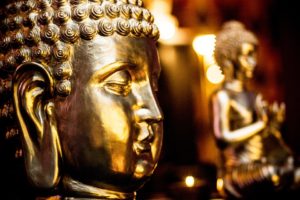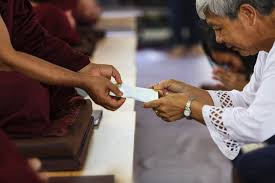“The Buddha claimed that the practices he advocated in the quest for enlightenment avoided the extremes of sensual self-indulgence on the one hand and self-mortification on the other and thus he gave his Noble Eightfold Path the alternative name of the Middle Way.” ~ “Dharma Date: The Middle Way”
According to the blog The Middle Way article “What Is the Middle Way?”, “The Middle Way lies at the very heart of Buddhism, as indicated in the words above, [which are] taken from the Buddha’s first sermon.” In fact, it is so cored to Buddhism that sometimes people use “the Middle Way” to describe the Buddhist way of life.
 Keeping in mind that the Middle Way avoids either extreme that humans tend toward, one can see how the Noble Eightfold Path reinforces that idea. The Eightfold Path is divided into three divisions:
Keeping in mind that the Middle Way avoids either extreme that humans tend toward, one can see how the Noble Eightfold Path reinforces that idea. The Eightfold Path is divided into three divisions:
– The first two are categorized as Prajna (sometimes spelled “Pranna”), or wisdom. These break the ignorance that traps people in an endless cycle of birth, suffering, and death. Suffering, those things that harm, do not have to be a part of existence forever. These are what tell a disciple what the Middle Way is.
– The next three are categorized as Shila (“Sila”), or morality. These stress not doing harm, which would violate the Middle Way.
– The last three are categorized as Samadhi, or meditation. These teach the body, thoughts, and emotions to stay on the Middle Way.
The Noble Eightfold Path
– Right view, according to “The Basics of Buddhism” by Dr. C. George Boeree of Shippensburg University, “is the true understanding of the four noble truths.” The Four Noble Truths are what describe the nature of suffering, dukkha. However, “dukkha” can refer to any type of stress, physical or emotional. Anxiety is a type of dukkah.
In short, the Four Noble Truths acknowledge there is suffering, identify attachment as the cause, inform one that attachment and the resulting suffering can be overcome, and that there is a way, dharma, to accomplish this. Understanding the Four Noble Truths takes away the ignorance that perpetuates dukkha.
Having the right view leads to greater knowledge.
The right view realizes that all attachments of this life are not permanent. All things in this world are impermanent, anitya. The normal notion of the individual self is also incorrect and leads to attachment. Rather, everyone is at their core a “no soul” or “not-self,” anatman. The sense of self leads to thinking in terms of “I,” “mine,” “yours,” etc. This aids attachment to temporary things, and when those temporary things cease to exist, suffering results.
It should also be noted that not just craving is a type of attachment. Avoidance or hatred is also a type of attachment but in a negative sense. The truth is neither in clinging nor in avoidance, but taking the path in the middle.
– Right resolve or right intention, which is to constantly work to free oneself of ignorance and attachment. It is a resolve to rid the mind of hatred, ill will, and harmful attitudes. Having the right resolve leads to greater liberation.
– Right speech means to stop all harmful talk, whether gossip, abusive talk, lying or that which divides others. Here, the avoidance of doing harm by speech upholds the concept of the Middle Way.
– Right action means avoiding harmful behaviors. Like the right speech, the emphasis is on harming others, but avoiding harmful actions toward oneself also qualifies. Wrong behavior, such as killing, stealing or wrongful sex, can hurt self or others.
– Right livelihood avoids occupations that promote harmful behaviors. Buddhism teaches that work can be used to support spirituality. Work that hinders one’s path is a wrongful livelihood.
It should be noted that livelihood is not just an occupation in the sense of obtaining money for goods or services. A stay-at-home mother is an occupation.
Another thing about the livelihood that is not usually explicitly stated in the description of the other steps in the Path is that life should not involve the harm of animals. For example, dogfighting is against Buddhist principles. According to Peter Harvey, author of An Introduction to Buddhist Ethics: Foundations, Values, and Issues, “To make one’s living as a butcher, hunter or fisherman clearly comes under the category of ‘wrong livelihood’ … to be avoided by all sincere Buddhists.”
 – Right effort means to enact good behavior and good thoughts, nurture them and put out the effort to abandon wrongful ones. It requires diligence and persistence. This stresses the ongoing nature of the Eightfold Path.
– Right effort means to enact good behavior and good thoughts, nurture them and put out the effort to abandon wrongful ones. It requires diligence and persistence. This stresses the ongoing nature of the Eightfold Path.
– Right mindfulness focuses on one’s mind and consciousness to rid themselves of ignorance, hatred, and desire. A disciple learns to become a detached observer of their own mind and feelings in order to analyze what is going on and stop wrongful thoughts and feelings.
– Right concentration or meditation is the means by which one suppresses wrongful attitudes by losing their sense of individual self. By placing full concentration upon something else, the sense of self is suppressed and one becomes awakened or enlightened. This then leads back to the right knowledge and right liberation, which are also results of Prajna.
The often-overlooked aspect
The Noble Eightfold Path stresses not doing harm. This results in peaceful coexistence with others. The entire process endeavors to alleviate suffering by not causing harm, to begin with. The literature tends to not mention this aspect except in passing. However, the whole goal is to end suffering. Buddha’s philosophy makes it quite clear that one cannot end their own cycle of birth, suffering, death, and rebirth while causing harm to others.
The entire process alternatively is called the Middle Way. Attachments to this life can be on the negative side via regrets, hate, and avoidance, or on the other positive side of craving, thirst, and lust. The Noble Eightfold Path keeps the disciple steered in between, or in the middle, of these extremes.





